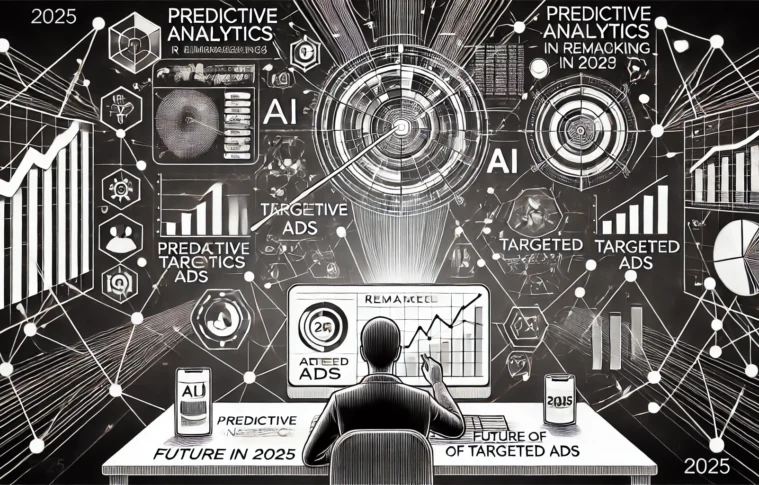In the ever-evolving world of digital marketing, predictive analytics has emerged as a game-changing tool for remarketing in 2025. By leveraging advanced machine learning and AI algorithms, businesses can anticipate user behavior and create hyper-targeted ads that drive conversions like never before. Predictive analytics allows marketers to go beyond reactive strategies and proactively engage users with the right message at the right time.
What is Predictive Analytics in Remarketing?
Predictive analytics involves using historical data, statistical algorithms, and machine learning to forecast future user actions. In the context of remarketing, it helps identify:
- Purchase Intent: Which users are most likely to convert.
- Optimal Timing: The best time to re-engage users for maximum impact.
- Preferred Channels: Platforms where users are most active and responsive.
- Potential Churn: Users at risk of disengaging, allowing preemptive action.
Why Predictive Analytics is Revolutionizing Remarketing
- Enhanced Personalization Predictive models analyze user preferences to deliver tailored ads, boosting engagement and conversions.
- Increased ROI By focusing resources on high-potential leads, businesses achieve better returns on their remarketing investments.
- Real-Time Insights Predictive tools process data in real time, enabling instant adjustments to campaigns for optimal performance.
- Efficiency in Ad Spend Predictive analytics minimizes wasted ad spend by targeting only the most relevant audiences.
Latest Trends in Predictive Analytics for Remarketing
- AI-Driven User Scoring Tools like Google Ads Predictive Insights and Adobe Sensei rank users based on their likelihood to convert, enabling precise targeting.
- Dynamic Content Optimization Predictive models determine which ad creatives resonate most with individual users, dynamically adjusting visuals and messaging.
- Omnichannel Prediction Models Platforms like HubSpot and Salesforce Einstein unify data across email, social media, and web interactions to predict user behavior seamlessly.
- Churn Prediction Algorithms AI identifies signs of disengagement, allowing businesses to deploy retention campaigns before users churn.
- Micro-Segmentation Predictive tools break down broad audiences into micro-segments, enabling hyper-focused ad targeting.
Case Study: Predictive Analytics in Action
Brand: WanderLuxe, a luxury travel booking platform.
Challenge: High website traffic but low booking conversions.
Strategy:
- Used Google Analytics 4 to analyze user data and identify browsing patterns.
- Implemented predictive models to score users based on purchase intent.
- Targeted high-intent users with personalized video ads on Instagram and YouTube, showcasing tailored travel packages.
- Deployed email campaigns offering exclusive discounts to users predicted to churn.
Results:
- A 60% increase in booking conversions within three months.
- A 25% reduction in customer churn.
- A 3x improvement in ROI for their remarketing campaigns.
How to Implement Predictive Analytics in Your Remarketing Strategy
- Choose the Right Tools Platforms like Google Ads, HubSpot, and Salesforce Einstein offer robust predictive analytics features for remarketing.
- Integrate Your Data Combine data from all customer touchpoints—web, email, social, and CRM—to build comprehensive predictive models.
- Define Key Metrics Focus on metrics like likelihood to convert, expected lifetime value, and churn risk to guide your campaigns.
- Create Adaptive Campaigns Use predictive insights to craft dynamic ads that adjust content, timing, and channels based on user behavior.
- Monitor and Optimize Continuously analyze campaign performance and refine predictive models to improve accuracy and effectiveness.
The Future of Predictive Analytics in Remarketing
- Hyper-Personalization AI-driven insights will enable one-to-one ad targeting, creating unique experiences for every user.
- Predictive Voice and Visual Search Integration Remarketing campaigns will incorporate predictions based on voice and visual search queries, expanding reach and relevance.
- Sustainability Insights Predictive tools will help businesses highlight eco-friendly products to users who prioritize sustainability.
- Real-Time Multi-Channel Integration Predictive models will provide seamless targeting across emerging platforms like connected TV and the metaverse.
Conclusion
Predictive analytics is reshaping the remarketing landscape in 2025 by empowering businesses to anticipate user needs and deliver highly relevant campaigns. By leveraging advanced tools and strategies, brands can achieve unparalleled efficiency, engagement, and conversions. As technology evolves, predictive analytics will remain a cornerstone of successful remarketing strategies, ensuring businesses stay ahead in a competitive digital world.


